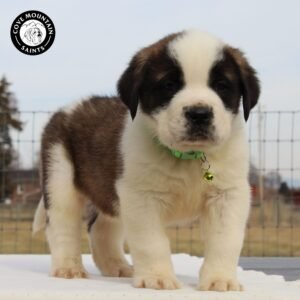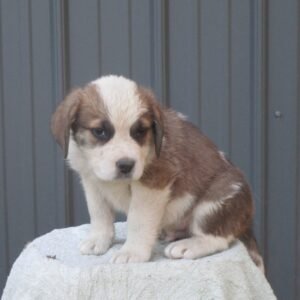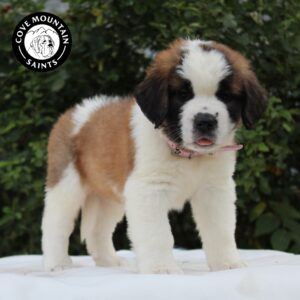Have a question about our Saint Bernard puppies?
"*" indicates required fields
overview of the Saint Bernard Dog Breed
Are you looking for a friendly, patient dog that’s giant-sized?
Check out our Saint Bernard puppies for sale below!
There’s nothing like a huge, laid-back dog that tolerates all the hugs, cuddles, and playing you desire! The Saint Bernard is a patient, calming presence that loves his family and is sure to bring you comfort and laughter.
Adopt your Saint Bernard puppy today and start enjoying the companionship of these steady, loving, and playful giant dogs!
You can also check out a few of our other available puppy breeds on our “all breeds” page.
Saint Bernard temperament
Patient: Saint Bernards are calm, patient, and tolerant. They are excellent family dogs and get along well with children. However, because of their size, they can accidentally knock over small children.
Friendly: Although they may be initially shy with strangers, Saint Bernards usually warm up to newcomers quickly. They love people and are not aggressive.
Not for Clean Freaks: Between drooling, shedding, and muddy paws, these loveable giants can make quite a mess!
Watchdog: Saint Bernard are not big barkers, but they’ll let you know if something isn’t right. In addition to sounding the alarm, a mere glimpse of these giant dogs will deter most unwanted intruders.
Loyal: Saint Bernards are loyal to their families and can be protective when they sense a potential threat. They may bark to alert their owners, but they are not typically aggressive without reason.
Adaptable: Saint Bernards can adapt to various living environments, including both urban and rural settings. They can thrive in apartments or houses with yards, but they do require space due to their size.
Sweet but a little Stubborn: There’s no doubt that Saint Bernards are absolute sweethearts, however, they can be stubborn at times. Be consistent with training and reward with praise and treats. Training a Saint Bernard is absolutely essential, as it’s one of the largest breeds. A 150+ pound dog that pulls on its leash or jumps up on people isn’t just annoying; it can be dangerous!
It’s important to note that individual Saint Bernards may have variations in their personalities based on genetics and upbringing. Early socialization and proper training are crucial to ensure they grow up to be well-adjusted and well-behaved companions. Additionally, Saint Bernards require proper care and attention due to their size, so potential owners should be prepared for the responsibilities that come with owning a large breed dog.
Saint Bernard Breed history
You’ve probably heard stories about Saint Bernards carrying brandy around their necks to travelers lost in the snow.
While it is true that Saint Bernards helped to find lost travelers buried in snow, the small brandy keg around their neck is a pure legend. The brandy keg was an invention of an 18th-century painter and has since become a symbol of the Saint Bernard.
Saint Bernards were originally farm dogs for farmers in the Swiss Valleys.
There was a hospice in the Alps above, started in 1050 by Bernard of Menthon, and it is thought that the farmers from the valley gave some of their dogs to the monks. The monks put these farm dogs to work as search and rescue dogs finding travelers lost in snowdrifts or avalanches.
The monks bred these dogs and around a century later, the dogs were legendary. Since the monastery was isolated (8,000 feet above sea level), the dogs developed a very distinct look as well as hardiness in cold weather and an even keener sense of smell. At one point the monks bred their dogs with Newfoundlands to improve their coats. However, the long hair simply became matted and frozen with snow and ice. The monks stuck with the short-haired dogs.
Although these dogs, along with the Saint Bernard hospice, were well known, they didn’t have an official name until 1833. The breed was many different names including Sacred Dogs, Alpendogs, and Barryhunden.
Charles Dickens mentioned the Saint Bernard Hospice and the work there in the book Little Dorrit, published in the mid 1800s.
The hospice records reveal that their dogs saved over 2,000 lives in the three centuries of records.
In 1833, the name Saint Bernard was decided upon as the official name for this courageous, yet gentle breed. In 1880 the Swiss Kennel Club recognized the breed, and in 1887 the International Congress of Zurich created the official breed standard for the Saint Bernard we know today.
You may have heard about the most famous Saint Bernard: Barry. Barry is said to have rescued the lives of forty people and is one of the most famous dogs in the world. Barry’s body is preserved by taxidermy in a museum in Bern. Disney produced a movie about Barry in 1977 called Barry of the Great Saint Bernard.
The Saint Bernard was recognized as a breed by the AKC in 1885 and today ranks forty-eight out of the breeds registered with the AKC. There are still Saint Bernards at the Saint Bernard Hospice. They no longer do search and rescue work but serve as living reminders of the heroic work done by their ancestors.
A few breeds similar to Saint Bernards include Bernese Mountain Dogs, Greater Swiss Mountain Dogs, and Newfoundlands.
Saint Bernard Average size
Female Saint Bernards are 26-28 inches tall at the shoulder and weigh 120-140 pounds. Male Saint Bernards are 28-30 inches at the shoulder and weigh 140-180 pounds.
As with any large breed, a Saint Bernard will need more space, more dog food, larger medication dosages, etc., than other dog breeds. Please consider the space, cost, and time required to care for a Saint Bernard before adopting!
Average Saint Bernard lifespan
Saint Bernards often live 8-10 years.
Saint Bernard body features
As a member of the Mastiff family, Saint Bernards have huge heads, wrinkled brows, and short muzzles.
There are two types of coats within the Saint Bernard breed: long-haired and short-haired.
Saint Bernards have two-color coats, with one of the colors always being white. They can be brown, red, orange, black, or brindle with white.
grooming Your Saint Bernard Puppy
Whether they have a short coat or a long coat, Saint Bernards will need their coats brushed weekly. During seasons of heavy shedding, they will need to be brushed daily.
Saint Bernards only need to be bathed occasionally or when they get dirty.
Your Saint Bernard will also need its nails trimmed and teeth brushed regularly.
Keeping Your Saint Bernard Puppy Healthy
Here are some health conditions that may affect your Saint Bernard.
As a giant breed, Saint Bernards are especially at risk for hip and elbow dysplasia.
Hip and elbow dysplasia occurs when the thigh bone doesn’t fit snugly into the hip and can result in arthritis or lameness if it’s not addressed.
Hip and elbow dysplasia can be genetic, or it can be caused by environmental factors such as overeating or injuries.
Here are some ways to prevent Hip Dysplasia in your Saint Bernard puppy:
- Ask the breeder for an OFA (Orthopedic Foundation for Animals) Hip Clearance. Dogs with Hip Dysplasia shouldn’t be bred.
- Talk to your vet about the best giant breed food for your puppy and stick to the correct amount to prevent unhealthy growth.
- Keep your puppy from running or jumping excessively on hard surfaces, or from standing on their hind legs.
Bloat, also called gastric dilatation-volvulus or gastric torsion, can affect any large breed dog and is a life-threatening condition.
Bloat is when the stomach becomes twisted, and the gases in the stomach are unable to escape. The pressure from these gases affects the blood flow to the heart, and it can be fatal.
To prevent bloat:
- Avoid feeding your dog right before or after heavy exercise.
- Feed them a few smaller meals a day instead of one large meal to prevent bloat.
- Learn to recognize the symptoms of bloat so you can take action immediately.
Some owners choose to have surgery done to tack their dog’s stomach in place and prevent it from twisting.
You can protect your dog from one of the most common health problems: obesity. One of the best ways to extend your dog’s life is by feeding them the correct amount of food and giving them adequate exercise.
Typical Saint Bernard Allergens
Allergens are caused by dander, which is dead skin cells. Both animals and humans shed these dead skin cells. Dander is attached to the fur that dogs shed.
Saint Bernards have thick double coats and are not considered an allergen-friendly breed. Regular brushing and bathing can help to lower allergens.
If you or someone in your home has animal allergy concerns, please consult your health provider before adopting a puppy.
- 1. What are Saint Bernards known for?When you think of a Saint Bernard, you probably think of a patient, loving, affectionate, and large dog. Saint Bernards are known for their gentleness with children. Saint Bernards are also famous for rescuing lost or sick travelers in the Alps during the 1800s and earlier.
- 2. Will a Saint Bernard protect me?Kind of. Saint Bernards are very protective of their family and bark if something isn’t right. However, they aren’t usually aggressive. Although they probably won’t attack someone, usually, just the sight and sound of such a large dog will intimidate intruders.
- 3. Do Saint Bernards shed a lot?Yes! Saint Bernards are large dogs, and that means more hair to shed! There are two kinds of Saint Bernards: shorthaired and long-haired. Both types of Saint Bernards have a thick double coat that keeps them warm in the winter and cool in the summer. In the spring and fall, they will shed their soft undercoat, which means heavy shedding. For the rest of the year, you can expect moderate shedding.
- 4. Do Saint Bernards slobber?Yes, Saint Bernard's slobber! You’ll want to keep a rag or cloth handy (you can hang them on door knobs or hooks) to wipe your dog's mouth. If this bothers you, do not adopt a Saint Bernard.
- 5. Are Saint Bernards easy to train?While Saint Bernards are sweet and patient, they can also be stubborn. A 150+ pound dog that doesn’t listen can be dangerous. Find a trusted dog trainer who can help you train your Saint Bernard!
- 6. What should I know before adopting a Saint Bernard?Before adopting a Saint Bernard, please consider the commitment it will require. Saint Bernards are large dogs! This means a significant responsibility. A Saint Bernard will need more space, more dog food, larger medication dosages, etc., than other dog breeds. If your Saint Bernard becomes injured and cannot walk, you’ll need a plan for moving your dog, especially up and down stairs. Please consider the space, cost, and time required to care for a Saint Bernard before adopting!
- 7. Are Saint Bernards the strongest dogs?Saint Bernards are known as the second strongest dog breed in the world, right after Mastiffs.
- 8. Are Saint Bernards suitable for first-time dog owners?Saint Bernards are not good for first-time dog owners because of their large size and tendency to be stubborn. In fact, Vetstreet.com lists Saint Bernard as one of the worst dogs for first-time dog owners.






















